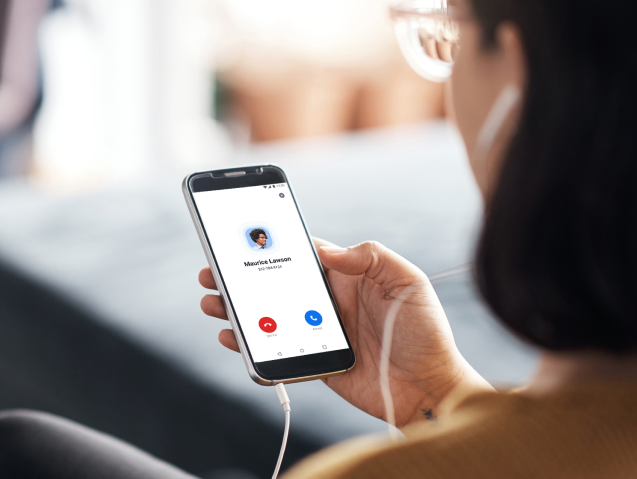Zoom Phone’s fast factsStarting price: $10 per license per month. Key features:
|
|---|

Most VoIP providers charge higher monthly fees and offer unlimited calling. Zoom Phone offers a potentially cheaper option for businesses with employees that just need to be reachable. If unlimited calling is overkill, Zoom’s pay-as-you-go plan is just as feature rich as competitors, but at half the cost.
Zoom Phone also offers standard and unlimited international calling options for more than 40 countries, making it a great choice for businesses outside of North America.
Featured Partners
Zoom Phone’s pricing
Zoom offers a broad array of communication products for businesses. Looking at Zoom Phone plans specifically, there are three different tiers to choose from:
- US & Canada Metered: Starts at $10 per user per month.
- US & Canada Unlimited: Starts at $15 per user per month.
- Global Select: Custom quote.
All of these plans come with the same features, so the best option for you depends on your call volume, your location and the locations of the people you talk with over the phone.
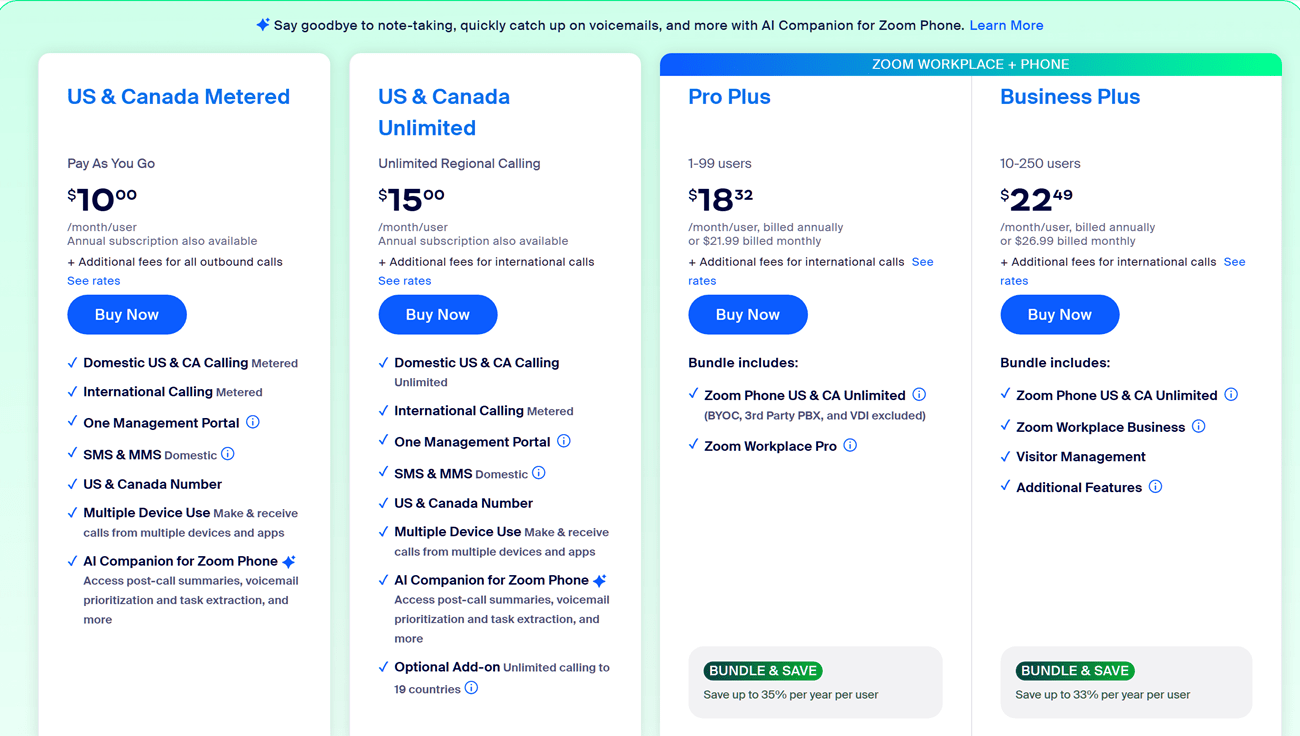
The Metered plan is a pay-as-you-go option for domestic and international calls. This plan is only a good value if each user averages less than eight minutes of calls per day. The cost for calls in the U.S. starts around $0.03 per minute.
For anyone averaging above that many calling minutes per day, the Regional Unlimited plan is a better deal. It’s worth the extra $5 per month for unlimited calling in the U.S. and Canada. Plus, you have the option to add on an international calling package for just $10 that supports unlimited calling in more than 15 countries.
The Global Select plan gives you unlimited domestic calling in one of 48 countries. This is good for teams based outside of the U.S. or companies with customers mainly based internationally. Be sure to see what type of phone service is supported in each country — for some it is local PSTN only whereas other countries support business text messaging (SMS/MMS) and toll-free numbers.
If you need other products from Zoom, the Pro Plus and Business Plus plans include Zoom Phone and Zoom Workplace for video meetings and team chat as an all-in-one platform. I would consider these bundles if you want to take advantage of the other channels Zoom supports, or if you are a large organization in a highly regulated industry, as Zoom released new compliance and privacy tools for enterprise Workplace customers.
Depending on your location, you may not have access to all of the options above. However, it’s likely Zoom has something that will work for you, even if you’re located outside of North America.
Zoom Phone’s key features
You get the same great Zoom Phone features with every plan. Standout basic features include call recording, Salesforce integration, BYOC capabilities and seamless transitions to Zoom Meetings. The most attractive add-on feature is their low-cost unlimited international calling.
Unlimited international calling (add-on)
Every Zoom Phone plan supports metered international calls. Regardless of your plan type, you can dial outbound worldwide.
There are two different ways to get unlimited global calls at an affordable price. The first option is by purchasing Zoom’s international calling add-on. For just $10 per user per month, you’ll get unlimited international calls to the following locations:
- United States.
- Canada.
- United Kingdom.
- Ireland.
- Australia.
- New Zealand.
- Austria.
- Denmark.
- France.
- Germany.
- Italy.
- Portugal.
- Spain.
- Sweden.
- Belgium.
- Netherlands.
- Switzerland.
- Puerto Rico.
- Japan.
Even if you’re only dialing outbound to a handful of these countries, $10 is an amazing deal compared to the cost-per-minute rates that you’d be paying without this plan.
The second option is a Global Select plan. This package lets you set up unlimited domestic calling in one specific country or region from a choice of more than 40 locations.
Say you have an office in South America or the majority of your customers are located in a country that’s not included on the $10 add-on list, you can still get unlimited calling within the country you select.
Zoom Phone’s international calling capability is arguably its best feature.
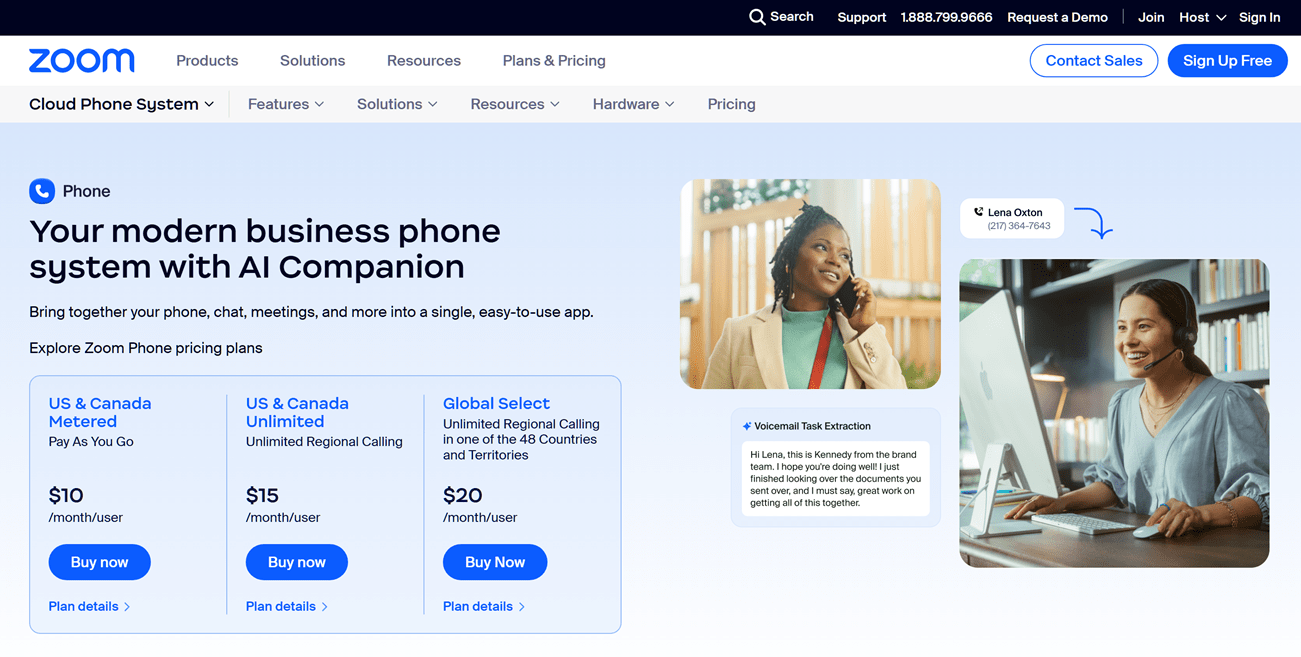
Automatic and manual call recording
Call recording comes standard with every plan.
This represents a potentially significant cost savings, as other phone systems charge extra for call recording or reserve it for higher-priced plan tiers. Some offer manual call recording on one plan but require you to upgrade if you want to automatically record calls.
Zoom’s recordings are automatically transcribed, making it easy to search for something specific during playback.
Native Salesforce integration
Zoom Phone only supports a handful of standard integrations, and Salesforce is one of them.
Other phone systems cost double or triple Zoom’s entry-level rate, and still don’t offer a Salesforce integration until you upgrade to an even more expensive plan tier. Zoom Phone allows you to integrate with Salesforce even if you’re on the base $10 metered calling plan.
With this integration, you can place calls, answer calls, send messages, access recordings and voicemails, and more — all natively through Salesforce without having to switch back and forth.
Bring your own carrier
If you want all the features and benefits offered by Zoom Phone but don’t want to break your existing phone plan contract, Zoom offers BYOC capability with every plan.
This lets you seamlessly migrate your on-premise PBX to a cloud-based phone solution.
Larger and more established businesses with a lot of phone numbers tend to take advantage of this feature. You can migrate to the cloud with a lower risk of service interruptions, and it’s faster to deploy this way.
The BYOC carrier feature is also an excellent option for multinational organizations with locations in other countries that are currently unsupported by Zoom. You can get a native phone carrier in any country, and then use Zoom Phone as your cloud calling platform.
Elevate calls to a Zoom meeting
You can quickly and easily turn any call into a full-featured Zoom Meeting without having to restart the conversation and force participants to manually join.
This seamless transition can happen directly within your Zoom mobile or desktop app — no need to set up a conference bridge.
For larger meetings and advanced features, you’ll need a separate subscription. But a basic meeting is free for up to 100 attendees and up to 40 minutes per call.
It’s a nice perk if you want to share your screen with the caller or collaborate beyond voice capabilities.
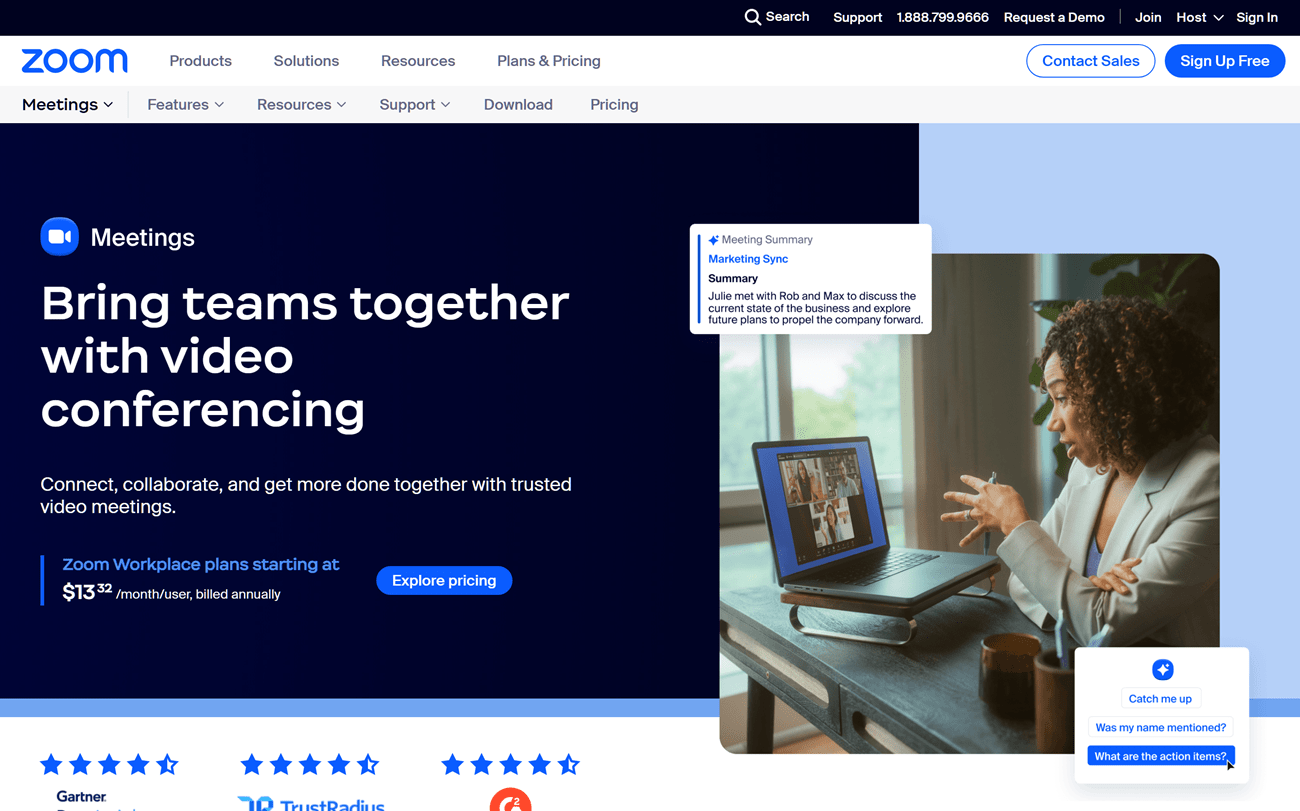
Zoom Phone pros
- Feature-packed at a low price.
- Compatible with VoIP desk phones.
- Mix-and-match plans.
- Centralized admin portal.
- Same price whether you pay monthly or for a year.
- Works for non-U.S. companies.
- Unlimited international calling options.
- Clean and simple interface.
- Inaudible watermarks for recorded calls.
- User provisioning via API.
Zoom Phone cons
- Full business communication plans are expensive.
- No annual discounts.
- Pricing is confusing.
- Newer than its competitors.
Alternatives to Zoom Phone
Many businesses elect to use alternatives to Zoom that are more established players in the business communications space. RingCentral and Nextiva offer the best unlimited U.S.-based calling plans. Zoom is cheaper — the tradeoff being that it is less feature rich by comparison — although it does have the edge over both of these providers for unlimited international calling and phone plans in non-U.S. countries.
You can also save money with Zoom if you don’t make a ton of outbound calls and don’t need the full range of communications tools (i.e., team chat, faxing and video conferencing).
See how Zoom Phone compares to all of its main competitors below.
| Zoom Phone | RingCentral | Nextiva | Ooma | 8x8 | |
|---|---|---|---|---|---|
| Starting price | $10 per user per month | $20 per user per month | $30 per user per month | $19.95 per user per month | Custom quote |
| Free trial | No | 14 days | Demo | No | No |
| Setup | Average | Complex | Easy | Very easy | Complex |
| Local phone numbers | 48+ countries | 105+ countries | None | None | 100+ countries |
| International calling | Unlimited to 15+ countries | Per minute | Per minute | Per minute | Unlimited to 14 or 48 countries |
| Call routing | Advanced | Advanced | Average | Basic | Advanced |
| Call recording | Yes | Yes | Top two tiers | Top two tiers | Contact center only |
| Other channels | Extra cost | Most plans | Most plans | Most plans | Yes |
| Integrations | 120+ | 300+ | 20+ | 10+ | 65+ |
RingCentral

RingCentral a very advanced phone system at an even more attractive price. Even its cheapest plan comes with IVR, powerful AI capabilities, quality of service analytics and full API access. If you’re a midsize or large business looking for something you can customize to match your needs, this is it. To learn more, read my review of RingCentral.
Nextiva

Nextiva offers the best balance of usability, easy set-up, price, scalability and functionality. It’s also a great choice if you’re focused on engaging or supporting customers across multiple channels. All around, it’s a premium phone system that’s surprisingly enjoyable to use. From implementation and ongoing support, Nextiva’s service team is the highest quality I’ve seen. Check out my review of Nextiva to learn more.
Ooma

Traditional office spaces that don’t do a lot of international calling will find Ooma much easier to implement and use. It’s far simpler than Zoom and offers pre-configured devices that only need to be plugged in. Plus, if you have a lot of office devices like desk phones and fax machines, they will keep working just fine using Ooma. It doesn’t get much easier than that. Learn more about this option and its easy deployment in my full review of Ooma.
8×8
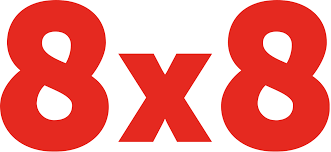
If you need more advanced capabilities and complete access to other business communications tools, 8×8 is likely a better choice than Zoom. This vendor can accommodate any existing tech stack, and has decades of experience helping large businesses adapt to the ever-evolving business communications landscape. 8×8’s unlimited calling to 48 countries also covers nearly 4x as many locations as Zoom. To learn more, read my review of 8×8.
Methodology
I evaluate all business communication tools, including Zoom Phone, based on a standard set of criteria. The goal is to provide readers with as close to an apples-to-apples comparison between Zoom Phone and its leading competitors.
Standard vs advanced features
I looked at key features that are included with standard Zoom Phone subscriptions and compared the package with other standard plans from competitors. Then I compared advanced plans head-to-head. I am most interested in which channels in addition to voice are supported (like video conferencing, SMS messaging, and live chat) and the depth of call handling features (like IVR, warm transfers, hot desking, and call groups).
Customer support
Beyond tracking down the general customer support availability — when they are available and which channels can you reach them on — I dug into real customer reviews to make sure that support options are attentive and capable.
Third-party integrations
Phone systems rarely work independent of other software, so I take a good look at the roster of potential third-party integrations. Do they offer pre-built integrations and technical support to ensure that everything is working as it should? For business phone systems, I am especially interested in CRM integration and how it connects with business intelligence tools.
Security and privacy
I did not consider business communications solutions where security or privacy was in a gray area. To be considered, vendors needed to offer both the secure infrastructure to support communications along with client-side tools for maintaining privacy, like role-based access control and multi-factor authentication.
Note: Zoom has had security issues in the past, and while some companies still refuse to use it, many banks and hospitals do. I doubt those organizations are lackadaisical in vetting Zoom as a business communication option. Zoom offers HIPAA-compliant VoIP (BAA included), which must meet very high standards for data protection and access control.
Demo or free trial
I look to let people know whether it’s possible to try the service for free or if the company only offers demos before you have to commit. This is important to me, because I like to “see how it drives” before signing up for a yearly subscription.
Overall cost
The sticker price per seat and what you wind up paying are two different things. The cost of a VoIP phone system is almost always driven up by add-on costs and fees. Is there a setup fee every time you want to add a new number or just a flat cost per month? What about phone extensions? Will people be able to BYOC or keep using legacy equipment? These are just a few of the questions I will ask to get at the total overall cost that buyers should expect.
